It took eight years of work, but restoration work on the sculptures by Michelangelo Buonarroti (Caprese, 1475 - Rome, 1564) in the New Sacristy of the Medici Chapels in Florence has finally been completed. The work, directed by Monica Bietti, an official art historian and former head of the Museum of the Medici Chapels, in agreement with the director of the Bargello Museums, Paola D’Agostino, involved both the tombs of the two Medici (Lorenzo, duke of Urbino, and his brother Giuliano, duke of Nemours) with the famous statues, and the New Sacristy’s vestments, and was conducted by a full-bodied team composed only of women: restorers Daniela Manna and Marina Vincenti, with whom Donata Magrini, Barbara Salvadori and Silvia Vettori, researchers at the Institute of Cultural Heritage Sciences of the National Research Council (ISPC-CNR), and Anna Rosa Sprocati and Chiara Alisi of ENEA (National Agency for New Technologies, Energy and Sustainable Economic Development) collaborated.
The intervention made it possible to recover the chromatic values of the walls of the New Sacristy and the sculptures, and to deepen technical knowledge that now allows us to better understand the construction phases and the method that Michelangelo applied in the realization of the whole. It was, the restorers explain, a long and complex undertaking, which was also successful thanks to a campaign of punctual investigations and the use of an innovative bio-cleaning technique developed by ENEA, used for the first time on Buonarroti’s masterpieces and in particular on the sarcophagi and part of the sculptures of the funerary monuments of Giuliano Duke of Nemours and Lorenzo Duke of Urbino. This is a technique that uses colonies of dirt-eating bacteria (specifically the strains Serratia ficaria SH7, Pseudomonas stutzeri CONC11 and Rhodococcus sp Z-CONT) to clean the marbles of signs of aging. The New Sacristy, Michelangelo’s last Florentine endeavor, was in need of thorough maintenance after the last conservation work in 1988.
Work began in 2013, but it was between 2016 and 2020 that the most substantial work took place, possible thanks to funds derived from the autonomy of the Museums following the 2014 Reform of the Ministry that established the first twenty museums with special autonomy, including the Bargello Museums. In addition, between 2018 and 2019, a partnership with IGT (formerly Lottomatica) enabled both the co-financing of part of the dusting and restoration and the creation of new lighting in the New Sacristy. The long and complex work was conducted starting with the marble and pietra serena pilasters that mark the architectural space of the walls, and concluding with the work on the sculptures in the second half of 2020. As well as the marble hangings, the sculptures were also covered with deposits and were in several places stained with residues of substances used in the past to protect the sculptures during the execution of the casts, which were made from the 16th century through the 19th century. The planning phase of the restoration was preceded and guided by Antonio Quattrone’s visible light photographic campaign and, between 2019 and 2020, by ultraviolet and infrared (IR) light-induced fluorescence photographic surveys carried out by Andrea Rossi, operations that ascertained the sculptures’ conservation status and allowed for the selection of the most suitable methodologies for the cleaning intervention. In collaboration with ISPC-CNR, significant areas on each sculpture were also identified to make colorimetric and reflectance measurements of the marble.
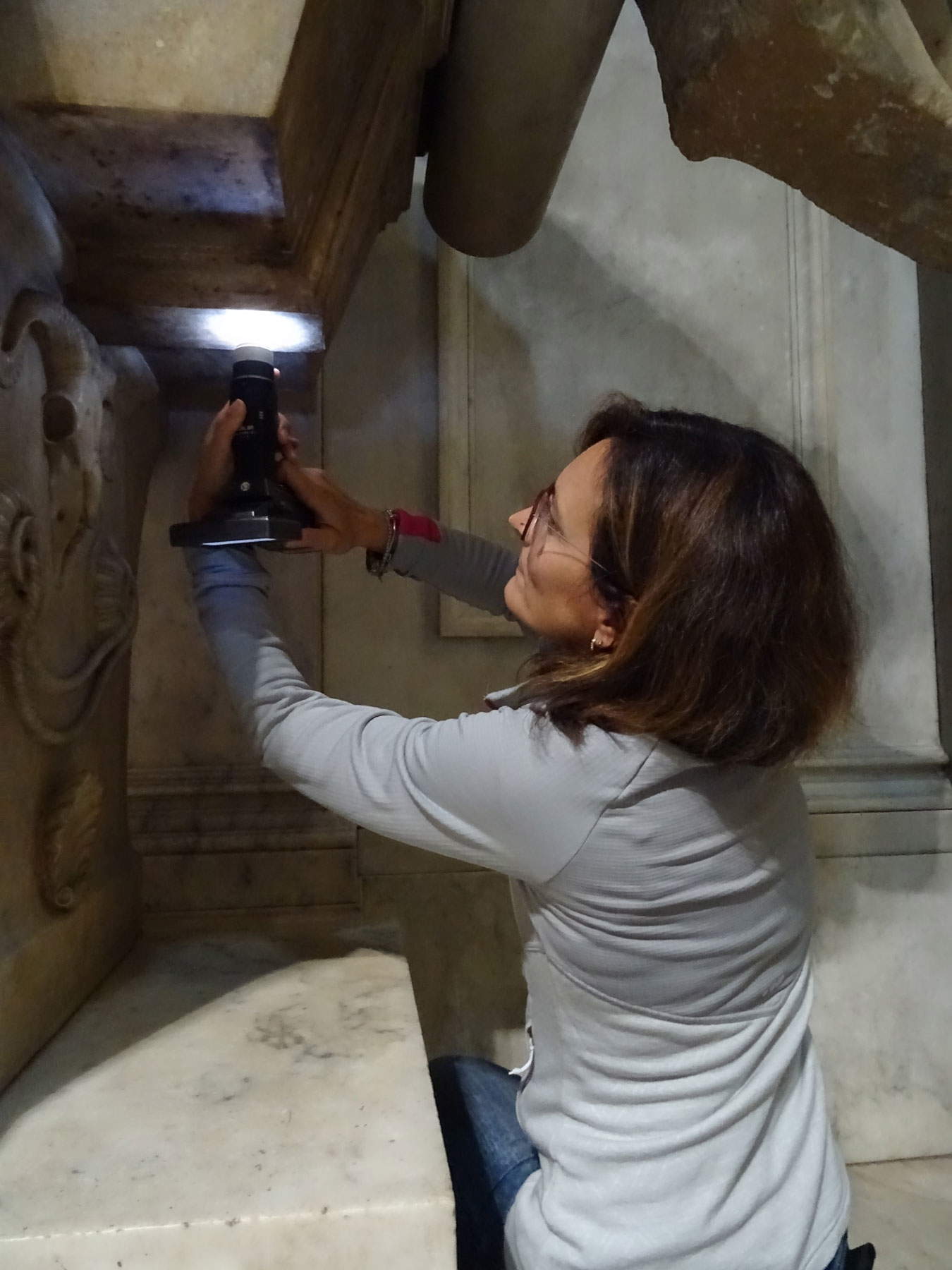 |
| Portable microscope observation on the sarcophagus of the funerary monument of Lorenzo de’ Medici, Duke of Urbino. Photo courtesy of the CNR. |
 |
| Colorimetric investigations on the statue of Night from the funerary monument of Giuliano de’ Medici, Duke of Nemours. Photo courtesy of the CNR. |
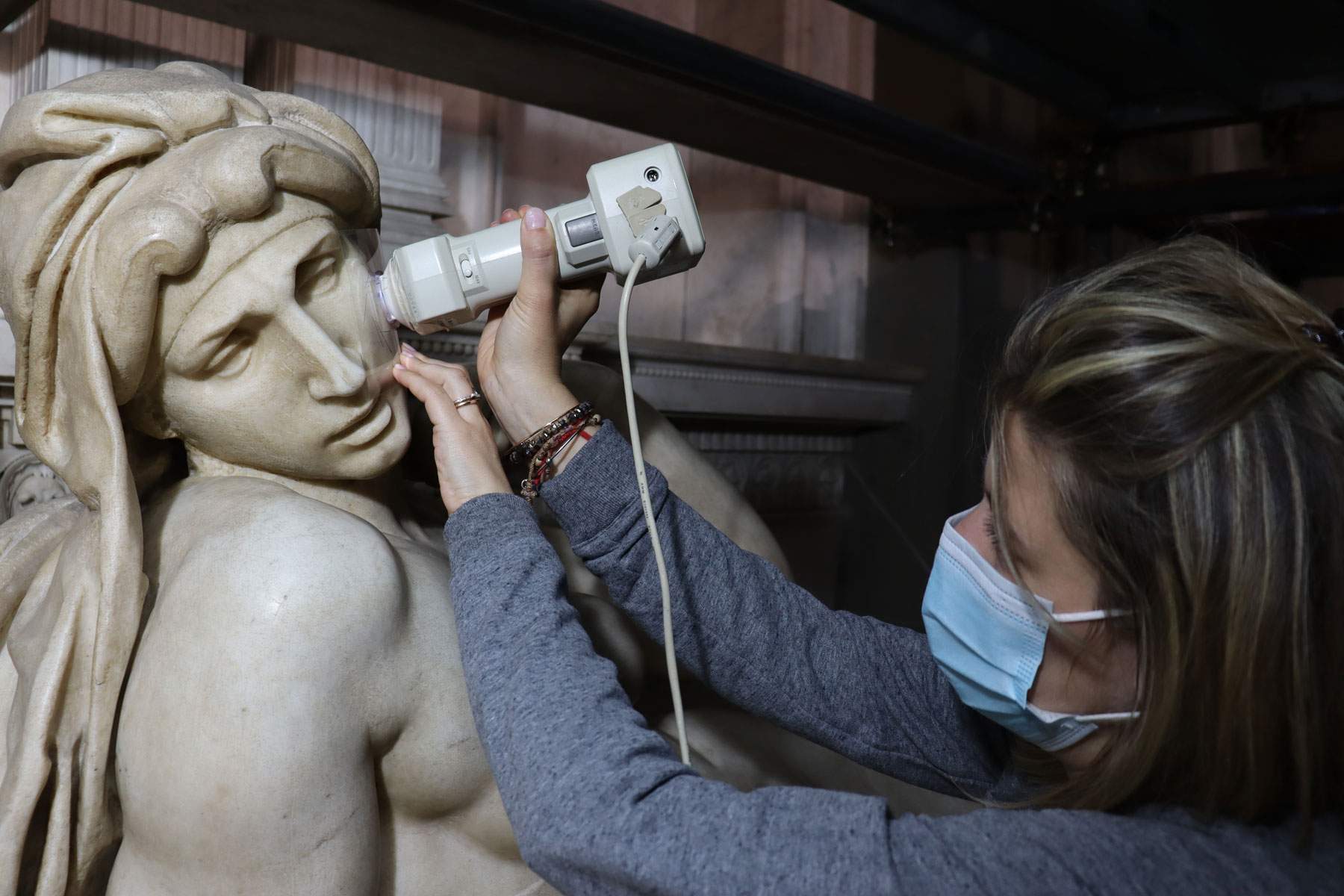 |
| Colorimetric investigations on the Aurora statue of the funeral monument of Lorenzo Duke of Urbino. Photo courtesy of the CNR |
The restoration of the Sacristy had an initial brief phase of work on the marble vestments in 2013. The work began with a series of preliminary cleaning tests on the stone facings of the south side of the Sacristy, identifying their forms of deterioration. The continuous flow of visitors, with the constant circulation of incoherent atmospheric particulate matter and its depositing on the surface of the marbles, had intensified their consistency especially due to the high humidity conditions. The thresholds of the entrance portals and the underside of all the pietra serena pilasters, subjected to the continuousrubbing of visitors’ hands, were blackened by both the accumulation of greasy substances and the wear and tear of the surfaces themselves.
“For the removal of the consistent deposits from the pietra serena elements,” Manna and Vincenti explain, “after thorough dusting, it was necessary to apply cellulose pulp and sepiolite compresses to support a 10 percent basic solution, interposing Japanese paper by varying the timing of application depending on the areas. The affected surfaces were then thoroughly rinsed with demineralized water. Marble vestments were treated with a 50 percent solution of decolorized alcohol and pure acetone using absorbent cotton tablets alternating with an apolar solvent, depending on the areas, to partially remove the altered waxy substances. Deposits of a more consistent nature were removed with demineralized water and soft compact sponges. Between 2013 and 2014, the restoration of the west wall was tackled with the same methodology prepared for the south wall. The restoration of the stone elements of the first register at the east wall was completed between 2015 and 2016.”
The experience gained in the first years of the intervention facilitated the operations: over the course of three years, it was therefore possible to complete the cleaning of the stone facings of the first register of the New Sacristy, where the only operational difficulties were the low temperatures detected during the winter months. Between the end of 2017 and the middle of 2018, to work on the marble walls with carvings attributed to Silvio Cosini and others, on which the funerary monuments of Giuliano and Lorenzo de’ Medici are set. The restoration was conducted by three female restorers with the collaboration of student interns from the Palazzo Spinelli Institute for Art and Restoration, thus falling within the planned timeline. “With the support of scientific investigations by Di.Ar., it was possible to verify the state of conservation of the marbles with non-invasive methodologies using the technique of fluorescence induced by ultraviolet light and with infrared lights,” Manna and Vincenti further explain. “In 2019, using an aerial platform, extraordinary maintenance work was put in place on the architectural elements in pietra serena stone of the last register of the Sacristy: stringcourses, cornices, windows and pilasters with capitals, including the apse.” During the work, a number of inscriptions were also found with reports of maintenance that had taken place, marked in pencil directly on the plaster: “1. Made the dusting to the whole chapel the month of April 25 1843; 2. Redone the dusting completed on March 19/.....; 3.Made the dusting on March 29 - 1940 Campigli Ugo Giulio Barbanti Bertino Berti.” From the end of September to the end of December the east side was completed, from the end of January to the end of July 2020 the west side, although work was suspended due to Covid-19. The cleaning of the marble and pietra serena elements was conducted according to the methodology matured during the last restorations, concentrating conservation interventions on the capital and the upper part of the northwest corner pilaster.
 |
| Colonies of bacterial strains used on Michelangelo’s sculptures from the New Sacristy of the Medici Chapels. Scientific name: SH7_Serratia. Photo courtesy of ENEA |
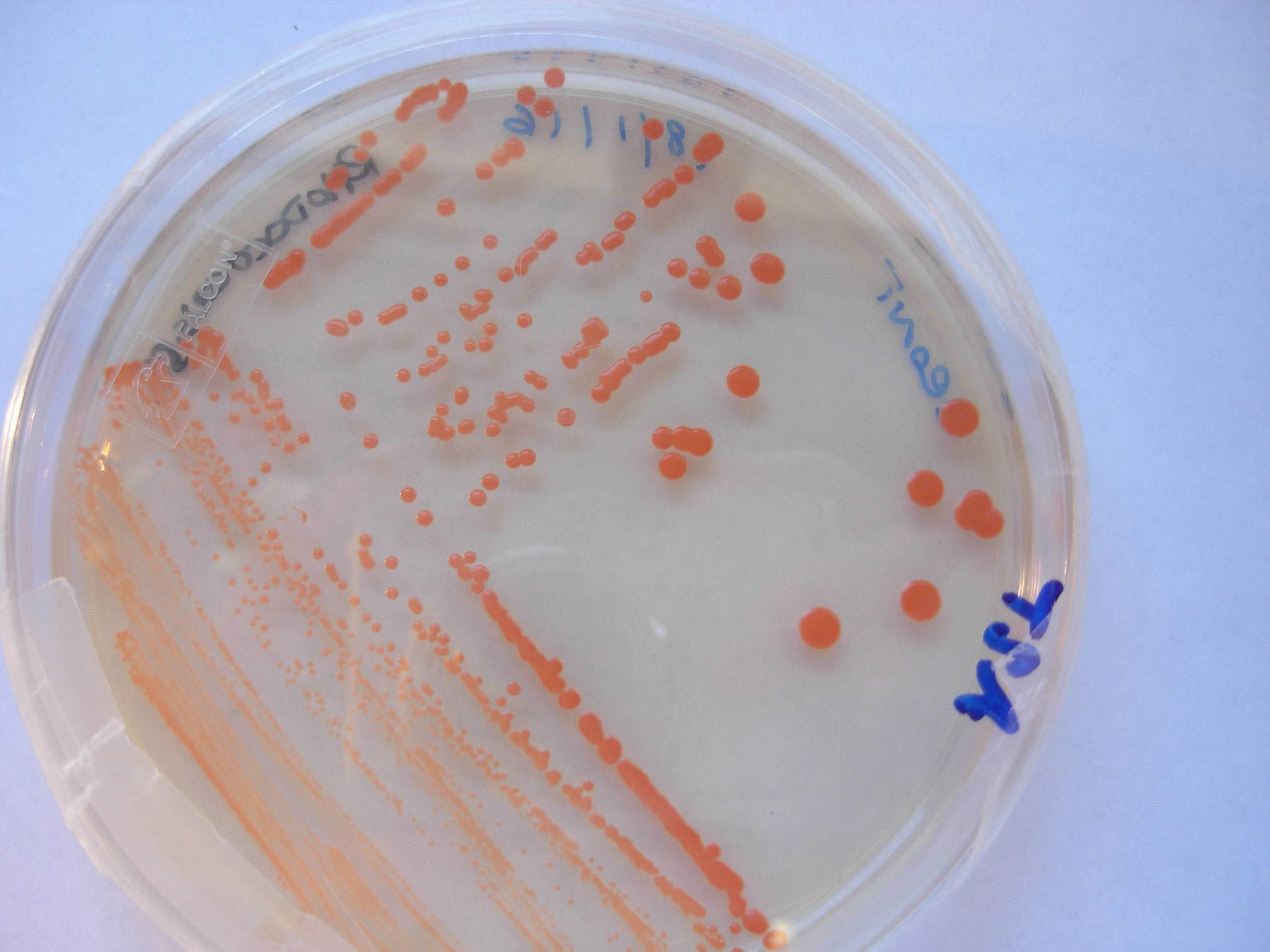 |
| Colonies of bacterial strains used on Michelangelo’s sculptures from the New Sacristy of the Medici Chapels. Scientific name: Rhodococcus sp.Z-CONT. Photo courtesy of ENEA |
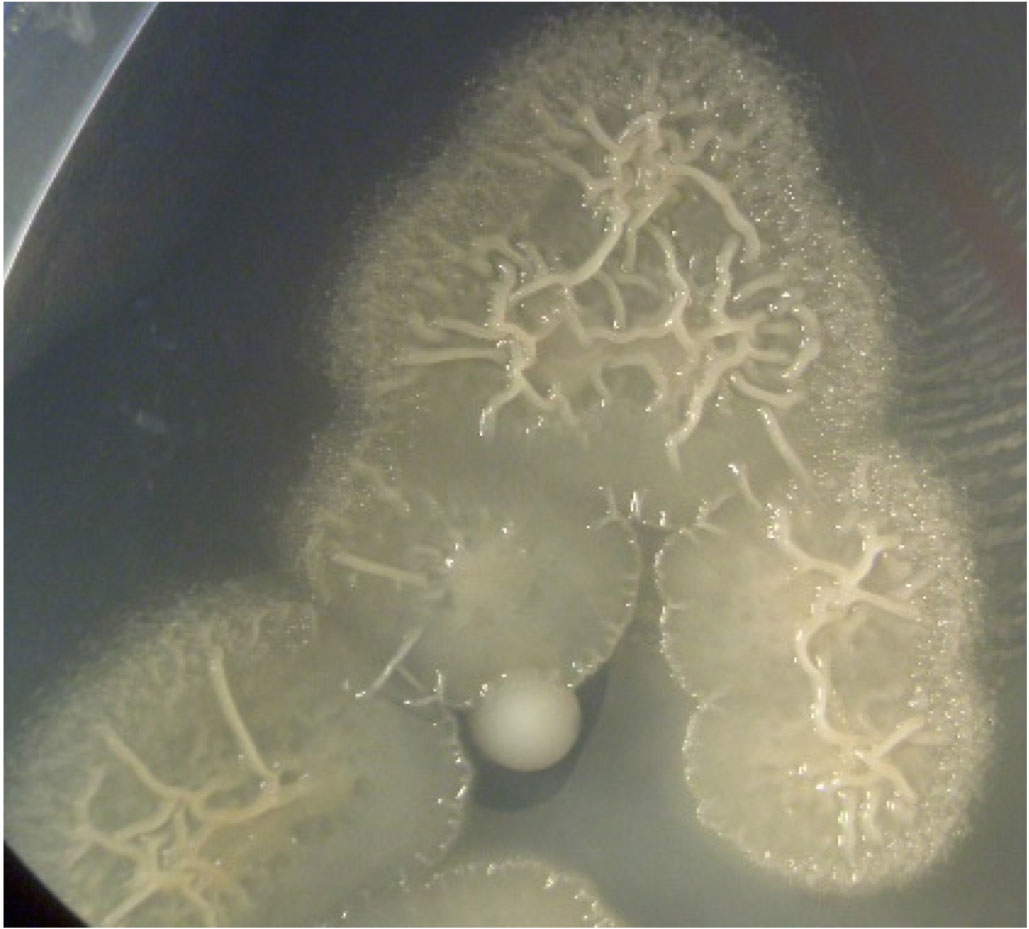 |
| Colonies of bacterial strains used on Michelangelo’s sculptures from the New Sacristy of the Medici Chapels. Scientific name: Pseudomonas stutzeri CONC11. Photo courtesy of ENEA |
 |
| Restoration site of the New Sacristy of the Museum of the Medici Chapels. Photo courtesy of ENEA |
The sarcophagus of Lorenzo duke of Urbino was altered by dark-colored stains, extended all along the base, identified by analysis performed by the CNR as oxalates and organic materials and traced back to organic liquids that seeped to the outside of the sarcophagus at these stains, to be traced to the burial of Alessandro de’ Medici (son of Lorenzo Duke of Urbino), who, having been murdered, was buried without being eviscerated, as was the custom at the time for the Medici dynasty. For the removal of these organic stains and others of various origins, such as phosphates, gypsum, traces of silicates, and traces of calcium oxalate, certain bacterial strains were identified that could selectively remove these deposits, without affecting the original material, the marble, with their action. That is, the strains chosen were neither able to precipitate nor solubilize calcium carbonates. After testing eleven different bacterial strains on small test plugs, the “best” three were chosen to proceed with the biocleaning of the sarcophagus. Cell packs of the strains Serratia ficaria SH7, Pseudomonas stutzeri CONC11 and Rhodococcus sp Z-CONT were applied to the different sites of the sarcophagus, immobilized in a special gel that maintains the right moisture for the bacteria and gives the right consistency to the pack, allowing it to be easily applied and removed, without leaving any residue, either of the carrier or of the bacterial cells. Bacteria have been applied, particularly... “hungry”: this is to encourage their “appetite” for the organic substrates to be removed and make the biocleaning treatment more effective. Two days to pack the sarcophagus and two nights of bacterial pack action, explain ENEA’s Sprocati and Alisi, made it possible to remove the deposits that strongly altered the sarcophagus.
“The restoration of the two funerary monuments took place from October 2019 to July 2020 with a suspension from March to June due to the Covid 19 lockdown,” Manna and Vincenti further explain. “Until March 2020, the restoration took place during public opening hours: an ’open worksite’ during which there were numerous moments of discussion with scholars and art historians and we answered the frequent questions and curiosities of visitors. Our approach was respectful and prudent in the removal of altered products present on the surface of the sculptures. The methodological approach of the restoration took into account the conservation history of the sculptures, reconstructed on the basis of research on photographic documents. In tackling the study of the sculptures’ conservation status, after careful visual analysis and photographic documentation in visible light by Antonio Quattrone and Daniela Manna, we enlisted the help of Andrea Rossi’s Di.Ar with a series of Ultraviolet and Infrared light photographic investigations useful in identifying strongly yellowed areas and others tending to brown, the presence of pigmented chalky material in the undercuts of the areas with strong signs of workmanship that found an explanation in the practice of calcining the sculptures. Indeed, on the surface of the sculptures the marks left by the incisions made with metal tools to remove the plaster plugs are still visible.”
The next phase of scientific investigation was entrusted to the team of the Institute of Cultural Heritage Sciences of the C.N.R. in Florence. The study used non-invasive methodologies, applied in situ, and micro-invasive methodologies, conducted in the laboratory on micro samples taken, with the aim of characterizing the altered materials present on the surface of the sculptures. The restoration work was accompanied by constant monitoring of the colorimetric and reflectance values of the worked marble. The cleaning of the sculptures and sarcophagi consisted of the removal of inconsistent deposits with soft brushes and low-powered vacuum cleaners, followed by the selective and gradual removal of the coherent deposits using a mixture of alcohol and acetone buffer and demineralized water buffer, constantly monitoring the cleaning with the help of colorimetric measurements. In November 2019, the team from ENEA’s Land and Natural Capital Protection and Enhancement Division in Rome was involved to perform some biocleaning tests with bacteria competent for substances on the surface of the sarcophagus of the Lorenzo Funeral Monument. In July 2020, the use of a laser scaler provided by the company El.En was requested in order to remove residues of cement mortar and mineralized protein substances tending to brown present on the Sarcophagus of the Monument to Lorenzo and near the left hand of the Twilight. Biocleaning of Lorenzo’s sarcophagus took place in October 2020. Biocleaning was chosen, Manna and Vincenti recount, because “it seemed to us to be a selective, gradual and soft method capable of attenuating and removing the conspicuous stains and residues of substances that have been present for centuries on the surface of the sarcophagus, a marble degraded due to drastic cleaning and mechanical abrasion. After the application of bacteria, we found that the marble has retained its textural cohesion and appears stable.”
“On the scaffold, face to face with Michelangelo’s Night and Dawn, too much beauty all at once causes us to feel dizzy,” Sprocati and Alisi say instead. “We need to hear what the restorers and art historians are telling us, stories within stories: representations, artists, events of the time, past restorations. The density of the stories and details of the works each time reveals to us the exceptional depth that exists beyond the surface that we know how to see. In turn, we tell stories of ’method and science’. We are biologists, ’gatherers’ of useful and harmless bacteria, powerful, invisible little cells, a true molecule factory. We search for them in hostile environments, where they have adapted to peculiar conditions, developing, by selective pressure, metabolic traits of special interest for biotechnological applications in different fields. We keep them in an in-house, i.e., self-managed, laboratory collection for now, but it will feed into the European MIRRI collection of microorganisms. If we learn about them we can ’guide’ them to express the functions we want them to, we can use them, for example, to make agriculture more sustainable, to clean up contaminated sites, to clean a work of art without using toxic and aggressive products. Here in the New Sacristy we have ’touched Michelangelo’. Working among art masterpieces is a bit awe-inspiring compared to a microscope, an incubator, a sterile hood in a laboratory.”
 |
| Detail of the funerary monument of Lorenzo Duke of Urbino before restoration with bacteria. Photo courtesy of ENEA |
 |
| Detail of Lorenzo Duke of Urbino’s funeral monument after restoration with bacteria. Photo courtesy of ENEA |
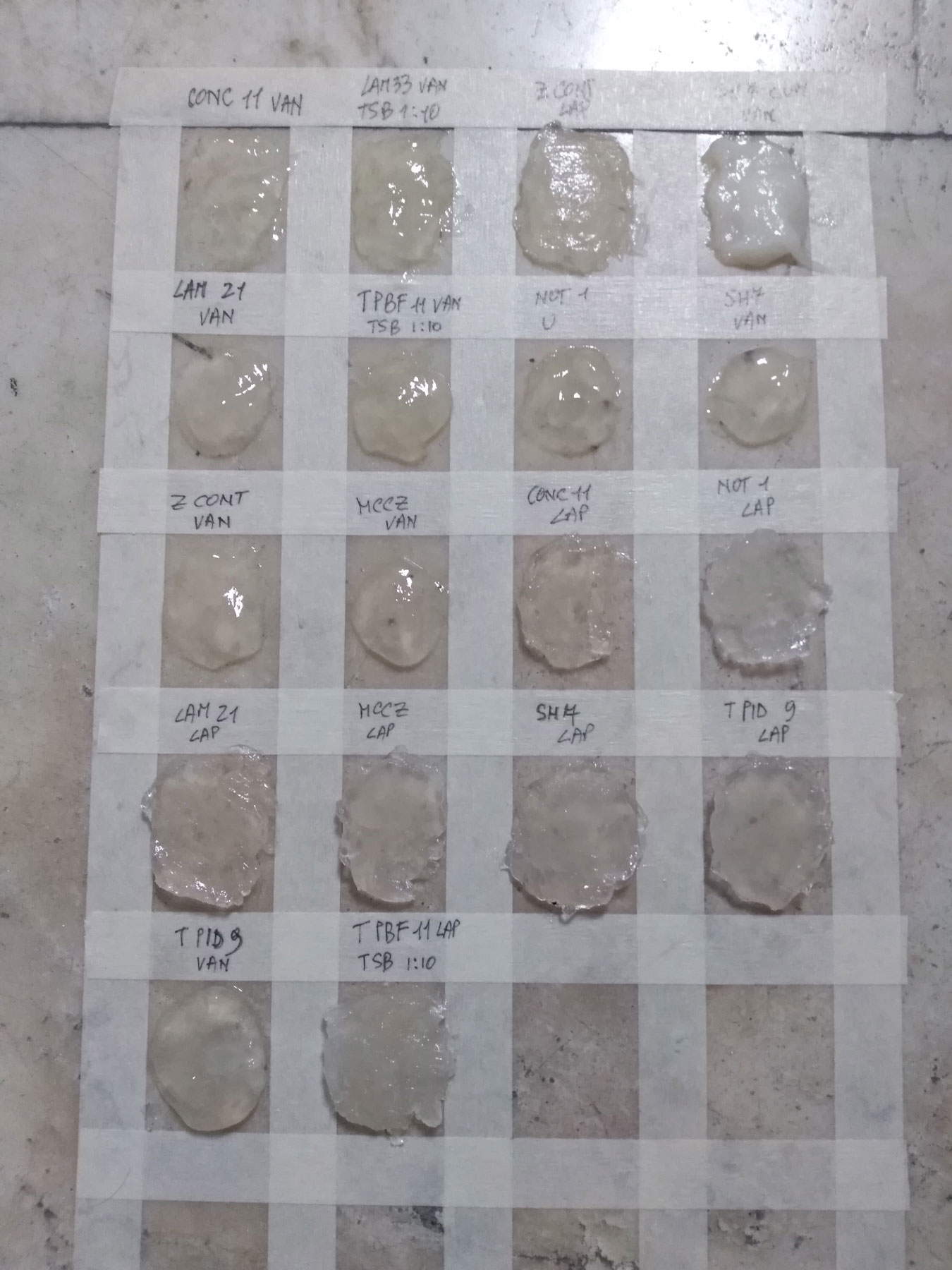 |
| Test with bacteria on the altar of the New Sacristy of the Medici Chapels Museum. Photo courtesy of ENEA |
 |
| Results after test with bacteria on the altar of the New Sacristy of the Museum of the Medici Chapels. Photo courtesy of ENEA |
 |
| New Sacristy, Michelangelo, Tomb of Giuliano Duke of Nemours, after restoration. Photo: Antonio Quattrone |
 |
| New Sacristy, Michelengelo, Tomb of Lorenzo Duke of Urbino, after restoration. Photo: Antonio Quattrone |
Paola D’Agostino, director of the Bargello Museums, says that “the conservative restoration and maintenance project, which over the past five years and in successive phases has seen the involvement of different professionals and institutes of excellence in Italian scientific research and innovation, now allows us to admire Michelangelo’s Florentine masterpieces with a new awareness of the very delicate phase of the choice and working of the marbles. I would like to thank Dr. Monica Bietti, the colleagues at Enea and CNR, and the skilled restorers who have worked for months on this delicate experimental restoration. The autonomy of museums, desired by the Honorable Minister Dario Franceschini, has also made it possible to finance, with their own funds, projects of protection, research and high scientific profile, such as the one concluded in recent months. I would also like to express my heartfelt gratitude to the architect Maria Cristina Valenti, Dr. Francesca De Luca and all the staff serving at the Medici Chapel Museum for following this project and always favoring the work of all the professionals, even during the very hard months of the health emergency that marked 2020 and the beginning of 2021.”
“The Sacristy,” says instead Monica Bietti, art historian and former head of the Medici Chapel Museum, “is a place where on the surface everything seems perfect: and instead the events of this space tell of a succession of difficulties and abandonment, of oblivion and rebirth. A story lived as if those marbles were not stones, but living things. The restoration of one of the symbolic places of art presupposes knowledge, experience, method and science combined with gifts of sensitivity, intelligence and openness to confrontation. That is why the work from the beginning was tested and then subjected to constant optical, methodological and scientific verification. The work of restoring the walls has made it possible to deepen the technical knowledge on the way of constructing or rather superimposing the marble slabs and on the way of executing the figurative, vegetal and modular decorations, a real exercise that allows one to distinguish the hands of Michelangelo’s collaborators, documented in this undertaking. Just as we understand very well that from the marble block chosen by Michelangelo for each figure, he by the method of ’levare,’ starting with a life-size model in the ground, finds the form, arriving at the finish through the use of different types of tools. The state of finishing of the sculptures varies according to the figures and also in relation to their location and relationship to the light source. And this is a novelty and a discovery made possible by the restoration.”
“At the conclusion of the restoration of the sculptures and stone vestments, we can say that inside the New Sacristy the material integrity of these works, which are a heritage of humanity, has been preserved over the centuries,” comments Marina Vincenti. “After the cleaning we can once again enjoy Michelangelo’s exceptional use of sculptural technique: an expression of his intimate relationship with marble and his ability to transform it into light. The constant change in the texture of the marks left by the working tools used makes alive and palpitating the symbolic and spiritual content of the man called upon to give form to the passage of time.”
“The New Sacristy is a true treasure chest where architecture and sculpture unify emotions,” says Daniela Manna. “The lengthy restorations, carried out over the course of seven years, followed a slow, respectful methodology, at times suffered due to the environmental conditions of the place, but starting from the walls they prepared the right setting to deal with the restorations of the sculptures of the great Michelangelo. Concrete aspiration would be to complete the restorations of all the architectural elements of the second level to monitor and unify the overall view.”
“The diagnostic project,” says Silvia Vettori, “involved the joint use of non-invasive methodologies, applied in situ, and micro-invasive, in the laboratory. The investigations made it possible to characterize the deposit materials and stains present on the stone surfaces, such as phosphates, oxalates and protein material, understanding the problems related to the state of preservation, and to evaluate the general effect of the cleaning operations, which proved to be effective but still prudent and respectful.”
“Selectivity, gradualness and respect for the material are necessary qualities for proper cleaning,” adds Anna Rosa Sprocati. “The biocleaning performed in the restoration of Michelangelo’s works met these needs. The bacteria used are spontaneous and harmless and were chosen from a large laboratory collection to be able to selectively metabolize the coherent deposits previously identified by chemical investigations, without pushing their action further. We propose the harmonic experience conducted in Michelangelo’s New Sacristy as a model of innovative and sustainable restoration that blends art history, restoration and science.”
 |
| Michelangelo's marble restoration at the New Sacristy ends: bio-cleaning with bacteria |
Warning: the translation into English of the original Italian article was created using automatic tools. We undertake to review all articles, but we do not guarantee the total absence of inaccuracies in the translation due to the program. You can find the original by clicking on the ITA button. If you find any mistake,please contact us.